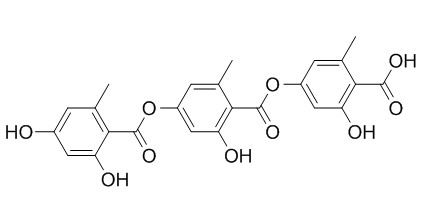Gyrophoric acid
Vulpinic and gyrophoric acids are known as ultraviolet filters for natural lichen populations, they can effectively prevent cytotoxic, apoptotic and cytoskeleton alterative activities of 2.5 J/cm(2) UVB in a dose-dependent manner, suggest that vulpinic and gyrophoric acids can be promising cosmetic ingredients to photo-protect human skin cells. Gyrophoric acid also has anti-proliferative/cytotoxic effect.
Inquire / Order:
manager@chemfaces.com
Technical Inquiries:
service@chemfaces.com
Tel:
+86-27-84237783
Fax:
+86-27-84254680
Address:
1 Building, No. 83, CheCheng Rd., Wuhan Economic and Technological Development Zone, Wuhan, Hubei 430056, PRC
Providing storage is as stated on the product vial and the vial is kept tightly sealed, the product can be stored for up to
24 months(2-8C).
Wherever possible, you should prepare and use solutions on the same day. However, if you need to make up stock solutions in advance, we recommend that you store the solution as aliquots in tightly sealed vials at -20C. Generally, these will be useable for up to two weeks. Before use, and prior to opening the vial we recommend that you allow your product to equilibrate to room temperature for at least 1 hour.
Need more advice on solubility, usage and handling? Please email to: service@chemfaces.com
The packaging of the product may have turned upside down during transportation, resulting in the natural compounds adhering to the neck or cap of the vial. take the vial out of its packaging and gently shake to let the compounds fall to the bottom of the vial. for liquid products, centrifuge at 200-500 RPM to gather the liquid at the bottom of the vial. try to avoid loss or contamination during handling.
J Agric Food Chem.2024, 72(45):25219-25228.
Pharmacogn Mag.2015, 11(43):562-6
J Ethnopharmacol.2017, 206:73-77
Braz J Biol.2023, 82:e266573.
Evid Based Complement Alternat Med.2021, 2021:5319584.
Korean J Dent Mater2020, 47(2):63-70.
Agriculture.2024, 69(3):140-148.
J Chromatogr Sci.2020, 58(6):485-493.
Appl. Sci.2020, 10(20), 7323.
JMSACL2023, 09.002
Related and Featured Products
Toxicol In Vitro. 2011 Feb;25(1):37-44.
Variable responses of different human cancer cells to the lichen compounds parietin, atranorin, usnic acid and gyrophoric acid.[Pubmed:
20837130]
The anti-proliferative/cytotoxic effects of four typical secondary metabolites of lichens (parietin, atranorin, usnic acid and Gyrophoric acid).
METHODS AND RESULTS:
Variations in the dynamics of tumour cell line populations were evaluated by the MTT, clonogenic and viability assays, cell proliferation and detachment, cell cycle transition and apoptotic nuclear morphology, thereby confirming their concentration- and time-dependent cytotoxicity. However, in comparison with parietin and Gyrophoric acid, the suppression of viability and cell proliferation by usnic acid or atranorin was found to be more efficient at equitoxic doses and correlated more strongly with an increased number of floating cells or a higher apoptotic index. Moreover, the analysis of cell cycle distribution also revealed an accumulation of cells in S-phase.
CONCLUSIONS:
This study has confirmed a differential sensitivity of cancer cell lines to lichen secondary metabolites.
Phytother Res. 2016 Jan;30(1):9-15.
Photoprotective Activity of Vulpinic and Gyrophoric Acids Toward Ultraviolet B-Induced Damage in Human Keratinocytes.[Pubmed:
26463741 ]
Vulpinic and Gyrophoric acids are known as ultraviolet filters for natural lichen populations because of their chemical structures. However, to the best of our knowledge, there has been no reference to their cosmetic potential for skin protection against ultraviolet B (UVB)-induced damage and, consequently, we propose to highlight their photoprotective profiles in human keratinocytes (HaCaT).
Therefore, vulpinic acid and Gyrophoric acid were isolated from acetone extracts of Letharia vulpina and Xanthoparmelia pokornyi, respectively.
METHODS AND RESULTS:
Their photoprotective activities on irradiated HaCaT cells and destructive effects on non-irradiated HaCaT cells were compared through in vitro experimentation: 3-(4,5-dimethylthiazol-2-yl)-2,5-diphenyltetrazolium bromide and lactate dehydrogenase assays, 4',6-diamino-2-phenylindole and tetramethylrhodamine B isothiocyanate-phalloidin staining protocols. Both of the lichen substances effectively prevented cytotoxic, apoptotic and cytoskeleton alterative activities of 2.5 J/cm(2) UVB in a dose-dependent manner. Moreover, vulpinic and Gyrophoric acids showed no toxic, apoptotic or cytoskeleton alterative effects on non-irradiated HaCaT cells, except at high doses (≥400 μM) of Gyrophoric acid.
CONCLUSIONS:
The findings suggest that vulpinic and Gyrophoric acids can be promising cosmetic ingredients to photo-protect human skin cells and should therefore be further investigated by in vitro and in vivo multiple bioassays.



